In this article we’re going to check out what chords are. I’m assuming you don’t know anything about chords – but it will be useful if you have read a little about scales, and especially that you understand what a major scale is.
Also, before we go any further, I want you to know that I’ve created reference posts showing pictures of all the different kinds of chords, and you can find them using this table — but you should really read the rest of this article first to get a sense for how to build the different kinds of chords.
Triad Reference Table of Contents
| Root Position | First Inversion | Second Inversion |
|---|---|---|
| Pics of Major Triads | Major Triads 1st Inversion | Major Triads 2nd Inversion |
| Pics of Minor Triads | Not Available | Not Available |
| Pics of Sus2 Triads | Not Available | Not Available |
| Pics of Sus4 Triads | Not Available | Not Available |
| Pics of Diminished Triads | Not Available | Not Available |
| Pics of Augmented Triads | Not Available | Not Available |
What is a chord?
A chord (pronounced like “cord”) is a group of three or more notes. (In this article and part two, we’ll focus on chords of only 3 notes; in part three, we’ll look at chords bigger than 3 notes.)
Chords with just three notes are called triads.
For example, here’s the chord of C Major:
C Major Chord

You can play these notes at the same time. You can play them at different times. It doesn’t matter – a chord is just a group of 3 notes. This chord is called C Major because it has the notes C, E, and G.
Parts of a Chord
It will be very important for you to understand that we have parts of a chord: the root, the 3rd, and 5th. (We also have the 7th, 9th, 11th, 13th – but we will get into those in part three.)
In the example of the C major chord, the note C is the root, the note E is the 3rd, and the note G is the 5th. Now, you’re probably wondering — why isn’t E the 2nd note, and G the 3rd note?
The answer is that chords come from scales.
Consider the C Major scale:
C Major Scale

The first note in the scale is C. In order to get the first chord, we play every other note until we have three notes. So we play C, skip D, play E, skip F, play G.
So, C is the first note (but we call it the root), D is the 2nd, E is the 3rd, F is the 4th, and G is the 5th. (You can keep going. A is the 6th, B the 7th, etc.)
Why do we care about what’s the root, what’s the 3rd, etc?
Well, here’s one reason to care. Play the C chord in the right hand and the root in the left hand, way down in the bass. All at the same time, like this:

What you’ll notice is a very powerful sound! Now I could say, let’s add the 5th to the bass. Which note was that again? G!

This, too, is a powerful sound, but a little more round.
So, if you take any chord you’re playing in the right hand, and add the root (and maybe the 5th) in the bass, you’ll add a lot of power to it. But you wouldn’t know which note to add if you didn’t know what the root and the 5th were!
The further you go in your musical studies, the more you’ll appreciate knowing the other parts of the chord, too.
The root is always the same note as the chord name. If you’re playing a G chord, G is the root. If you’re playing a C chord, C is the root.
You can figure out what the other parts of the chord are just by counting the letters. Let’s take D major. The notes are D, F#, A.
D Major Chord
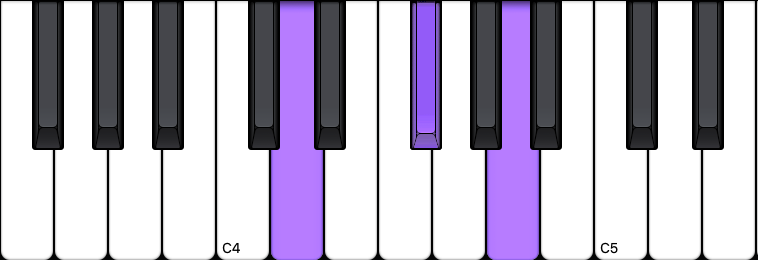
So, D is the root. Count from D to F.
D(1) — E(2) — F(3). So F# is the 3rd.
(It doesn’t matter that it’s F sharp and not just F. What matters is how many letters you counted. D to F is a 3rd, and D to F# is a 3rd. They are different kinds of 3rds but that’s beyond the scope of this article.)
Count from D to A. D E F G A — five letters up, so A is the 5th.
The distance between two notes is called an interval. D to F# is a 3rd. D to A is a 5th. F# is the 3rd of the chord of D. A is the 5th of the chord of D.
The important thing to remember when counting intervals like this is that the first note counts as 1.
Major Chords
The first two kinds of chords you’ll learn are Major and Minor. There are also Suspended, Augmented and Diminished. We’re going to look at all of them in this article. There are 12 of each kind – 12 major, 12 minor, 12 suspended, etc.
These words which describe the chord – major, minor, diminished, augmented, suspended – are called qualities. Quality is a fancy word that means “What kind of chord is it?”
So. Back to our C Major chord:
C Major Chord

It’s called “C” because C is the root. But why is it called major?
As with the major scales, there’s a code that will help you build a major chord:
R + 4H + 3H
Root + 4 half steps + 3 half steps. Starting from C, count up 4 half steps. You’ll land on E:
(Unlike with intervals, where we’re counting just the letters – when we count half steps and whole steps, we have to start with 0. It’s not a step until we go somewhere, so if you just play the note C, you haven’t moved anywhere, therefore it’s 0 steps.)
Ok, now you’ve got C and E. Count up three more half steps and you land on G:
So, to recap:
- A chord has 3 or more notes
- Root, 3rd, 5th are the parts of a triad (a three-note chord)
- The name of the chord is the same as the root. C Major has the root of C. G has a root of G, etc.
- The code for a major chord is R + 4H + 3H
- There are 12 major chords
Check out this article on a way to group the major chords for faster learning.
Minor Chords
I’ll give you the code for a minor chord, but as we’ll see shortly, there’s an easier way to find the minor chord of any major chord you already know.
The code for a minor chord looks like a major chord, but the 3 and 4 are reversed:
R + 3H + 4H
Here is C Minor. In this case we counted up 3 from C, landing on Eb, and then 4 up from Eb lands on G.
C Minor Chord
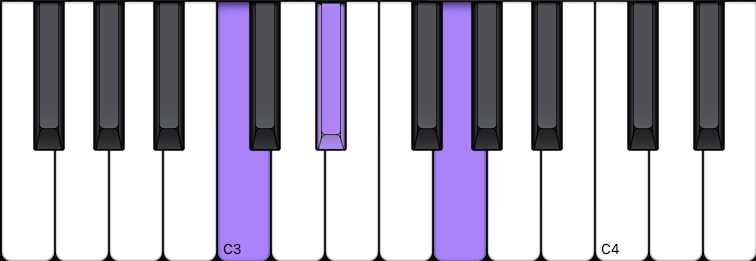
You might have noticed something here. The only difference between C Major and C Minor is that we flatted the 3rd. (Changed E to Eb.)
This always works with all major chords. Let’s look at D Major to D Minor:
What’s the 3rd of D Major? F#. So we flat it, and we end up with F♮ (natural).
D Minor Chord

Check out this article on a way to group the minor chords for faster learning.
Diminished
Here’s the code for a diminished chord:
R + 3H + 3H
From a major chord, flat the 3rd and 5th to get the diminished. (C Major is C E G; C diminished is C Eb Gb)
From a minor chord, flat the 5th to get the diminished. (C Minor is C Eb G; diminished is C Eb Gb)
Here are a couple of examples of diminished chords:
C Diminished Chord
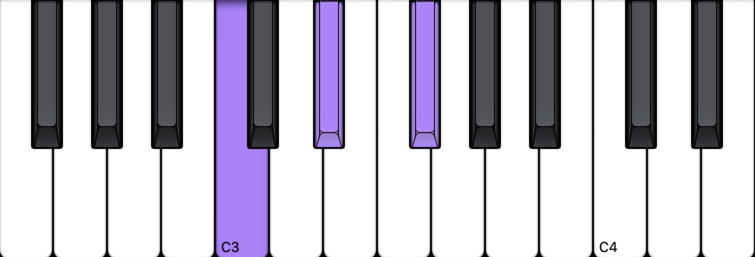
B Diminished Chord
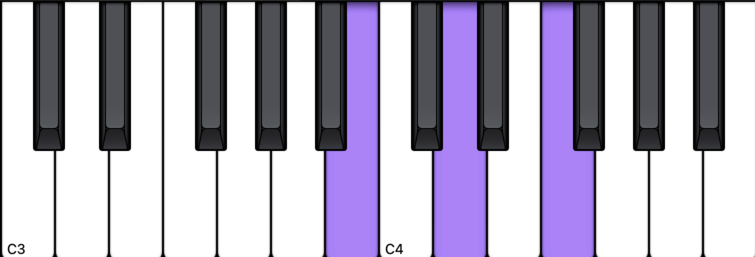
Suspended (Sus4 and Sus2)
If you know your major chord, just replace the third of the chord with the second note in the scale, or the fourth note in the scale. This will give you a suspended 2nd or a suspended 4th chord, which we almost always refer to by their short names: sus2 or sus4.
C Major Scale

Here’s the C Major Scale. From this we can get the C Major Chord:
C Major Chord

Now, since this scale is all white notes, our job is pretty easy. Replace the E with a D to get a sus2 chord:
Csus2 (C Suspended 2)
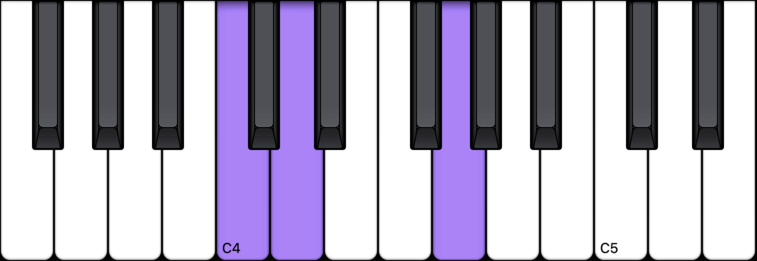
Or replace the E with an F to get a sus4 chord:
Csus4 (C Suspended 4)
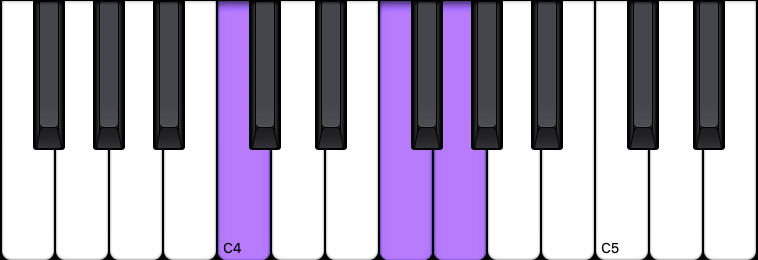
Try playing Csus4 and then C major. You’ll hear this sound in music all the time! It’s a nice resolution.
Example using D major – Dsus2 – Dsus4
Let’s look at one more example using D. Here’s the D scale:
D Major Scale

Check out the first five notes. D E F# G A. So, applying every other note to get the D Major chord, we have:
D Major Chord

Now, change that F# for the second note in this 5 note scale. F# goes to E:
Dsus2 (D Suspended 2)
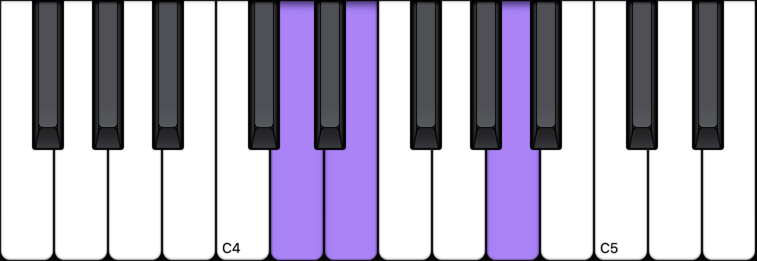
Or, change the F# for the fourth note (G), and you have Dsus4:
Dsus4 (D Suspended 4)
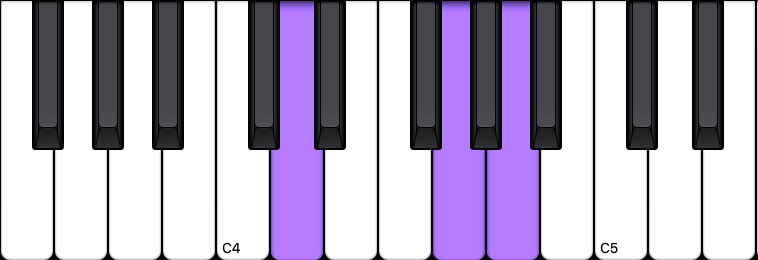
Note: “sus4” chords are almost always referred to just as “sus”. “Csus” would by default mean Csus4. Usually, Csus2 is written with the number 2.
If you like the formulas, you can just look at these chords to figure out what the formulas would be… but I’ll print them here in case it helps:
Sus2 chord formula
Root + 2H + 5H
Sus4 chord formula
Root + 5H + 2H
Augmented (#5)
Last but not least, we come to the augmented chord, also know as the “sharp 5” chord.
Take C Major. The 5th of C is G. Sharp it, and you get G#. Therefore, C Augmented or C#5 looks like this:
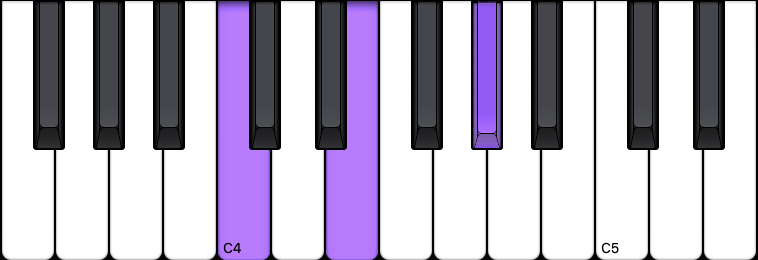
As with the diminished chords, playing this chord by itself might not be a very appealing sound to your ears, but in the context of other music, it’s a delightful color.
Here’s another example, let’s take A Major:
A Major Chord
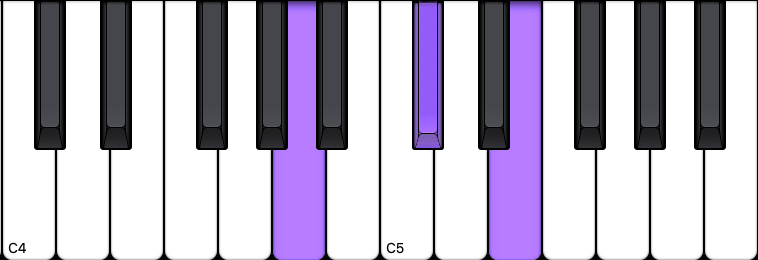
The 5th is E. Sharp it, and you get E#, which looks just like F♮ (natural):
A Augmented (A#5)

Here’s a formula:
Root + 4H + 4H
All the Chords in a Scale (Diatonic Chords)
Because there are 7 notes in a Major Scale, there are also 7 chords that belong to a Major Scale. We just move up the scale with the chord structure of every other note, like this:
Diatonic Chords in the Key of C
These chords would be called the “diatonic chords” of the key of C. Diatonic is a fancy word that means “belongs to the key.” You might not know much about “keys” yet, so for now you could think of it as “belongs to the scale.” All the white notes belong to the scale of C, and all the black notes do not.
I’ll be writing a whole article on diatonic chords, and when I do I’ll link it up here.

I’m Andy Grall, and I teach piano online and in Houston, TX. If you’re ready to dive in to learning piano, schedule your free consultation now:
Or, if you’d just like to support my work (thanks!):